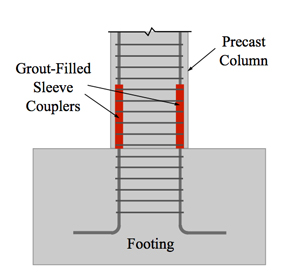
New ITD research project evaluates seismic performance
of grouted couplers in Accelerated Bridge Construction
Anticipating increased demand for accelerated construction to minimize inconvenience to drivers and reduce construction time and cost, ITD's Bridge Section is working through the Research Program to evaluate bridge couplers that may be necessary in Idaho's seismic conditions. Besides saving time and money, and reducing the impact to motorists, this may also improve the durability of bridge structures.
Accelerated Bridge Construction (ABC) methods are relatively new in the U.S. and Idaho, and use of ABC has been somewhat limited in areas with moderate to high seismic activity.
Pictured on left is a pre-cast bridge column. Below on right is an illustration of the grout coupler's use.
The Bridge Section requested Research Program funding to evaluate the seismic performance of couplers that can be used to connect pre-cast bridge columns to footings in ABC projects. These 'grouted coupler with no pedestal' (GCNP) connections must have adequate ductility to perform well under Idaho seismic conditions. Use of these connections has the potential to reduce construction time vs. traditional cast-in-place connections, and could result in cost savings and improved bridge performance.
 Researchers Arya Ebrahimpour and Andrew Sorensen from Idaho State University will compare the performance of the GCNP connections to conventional cast-in-place connections. Project tasks include: (1) performing a comprehensive literature review on seismic requirements of the column-to-footing and column-to bent cap connections in ABC methods; (2) developing computer models for both cast-in-place and GCNP connections; (3) using the models to analyze the seismic performance of the GCNP connections with three representative Idaho bridge designs; and (4) developing guidance that can be included in the Idaho Bridge Design Manual specifying acceptable applications of GCNP connections.
Researchers Arya Ebrahimpour and Andrew Sorensen from Idaho State University will compare the performance of the GCNP connections to conventional cast-in-place connections. Project tasks include: (1) performing a comprehensive literature review on seismic requirements of the column-to-footing and column-to bent cap connections in ABC methods; (2) developing computer models for both cast-in-place and GCNP connections; (3) using the models to analyze the seismic performance of the GCNP connections with three representative Idaho bridge designs; and (4) developing guidance that can be included in the Idaho Bridge Design Manual specifying acceptable applications of GCNP connections.
To complete Tasks 2 and 3, the Open System for Earthquake Engineering Simulation (OpenSees) software will be used. This software has been developed at the Pacific Earthquake Engineering Research Center at the University of California, Berkeley. It is a framework for simulating the seismic response of structural and geotechnical systems.
ITD Bridge Section engineering staff Matt Farrar, Dan Gorley and Leonard Ruminski; Research Program Manager Ned Parrish; and FHWA Bridge Engineer Ed Miltner will serve as the Technical Advisory Committee for the project, expected to be completed in June of 2016.
Published 02-27-15